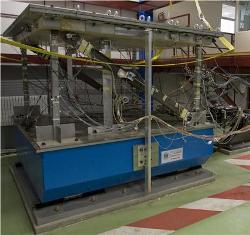Oct 31 2009
Researchers from the Buildings and Hydraulic Engineering Department of the Granada University are working on the design of energy dissipaters, that is, devices that act as the fuses of an electrical system during an earthquake, causing the buildings to better withstand the movement.
The UGR experts propose low cost technologies, easy to install and with evaluation systems to verify their durability. It is an Excellence Project of the Department for Innovation, Science and Commerce headed by Professor Amadeo Benavent, having received funding of 569,668 Euros.
 Seismic table installed in the Buildings Laboratory of the UGR to simulate earthquakes
Seismic table installed in the Buildings Laboratory of the UGR to simulate earthquakes
This passive energy dissipation technology reduces the seismic vulnerability of the structures designed with the old seismic regulations. It improves and increases the response levels in new buildings. Therefore, in case of an earthquake, the damage is concentrated on the dissipaters thus protecting the rest of the building.
The use of energy dissipaters is widespread in Japan, the United States and some European countries, but this is not the case in Spain. The innovation of the devices developed by the Granada University lies in improvements such as its low cost, the easiness of the installation and the possibility of predicting when these devices will break down, that is, the limit of their capacity.
Until now, these dissipaters, damaged by earthquakes, have been replaced by new ones since it is impossible to know if the devices could continue working. The researchers propose devices that may diagnose the damages and decide if it is necessary to replace these devices after the earthquake. Moreover, the project seeks to advance in non-destructive techniques to asses the damage in reinforced concrete frames, where they intend to install the dissipaters.
The investigation is supplemented by a course of action focused on industrial marketing which is aimed at facilitating the implementation of the new product in the market. According to the head investigator, Amadeo Benavent, they wish to "propose a model by surveying professionals, such as engineers and architects, with the purpose of creating a technology with an Andalusian seal to export it nationally and internationally".
Simulating an earthquake in the laboratory
The method for the development of these new devices have an experimental part and a numerical or analysis part. The first includes dynamic tests in the new seismic table installed at the end of 2008 in the Buildings Laboratory of the Granada University. This system - unique in Andalusia and the second in Spain, in benefits and size (3x3 meters) - permits the simulation of real earthquakes on scale models of buildings and to assess the effectiveness of the dissipaters.
The numerical part includes the advanced signal treatment and the numerical simulations with a new damage model designed by the same researchers in earlier works. It seeks to predict the buildings' seismic resistance, that is, how much energy buildings can absorb without collapsing.
Source: http://www.andaluciainvestiga.com/english/